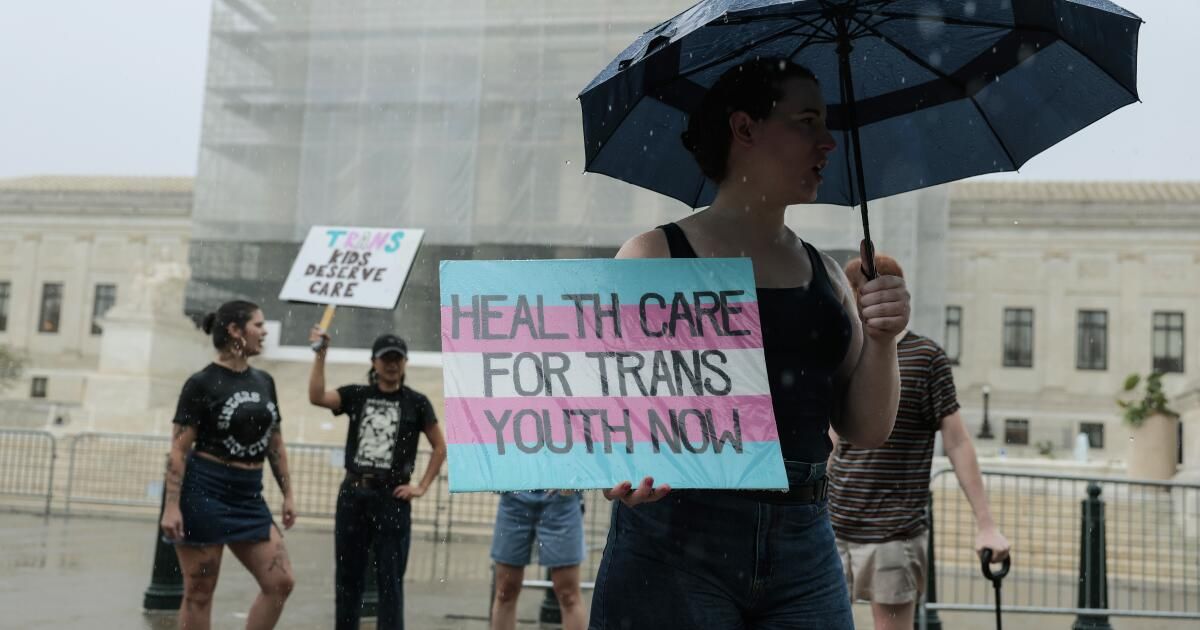In recent months, the Trump Administration has finished thousands of medical research subsidies financed by the federal government, destroying $ 9.5 billion in critical efforts of health sciences. More than half of those cuts, 1,246 subsidies worth $ 5.5 billion, specific studies focused on LGBTQ+health. These cuts not only reflect the priorities of changing policies. They also run the risk of limiting the scientific ideas that report clinical care and support the health of all Americans.
As of February, thousands of scientists received abrupt warnings to finish financing for vital research involving LGBTQ+populations. The justification? His research was considered “based mainly on artificial and non -scientific categories, including amorphous equity objectives.” A letter even stated that “research programs based on gender identity are often not scientific, they have little return of identifiable investment and do nothing to improve the health of many Americans.”
The subsidies that ended underwent strict peer review before financing and covered a wide range of important issues, from Alzheimer's disease and breast cancer to the well -being of the caregiver and school safety. In many cases, the common factor cited in its termination was simply the inclusion of LGBTQ+ populations within the scope of the investigation.
When groups of people are excluded from research, send a message on whose health is prioritized. The disproportionate elimination of LGBTQ research is more than a political decision or political maneuver. It weakens the basis of evidence -based attention. Research is essential to understand health risks, evaluate treatments and improve care for people who need it most. When research financing is withdrawn, medical care is left behind and, collectively, we all suffer.
LGBTQ+ people represent almost 10% of the American population, and long -standing research shows that face significant health disparities. Many of these gaps remain little known due to limited studies. For example, lesbian, gay and bisexual populations experience higher rates of substance use disorders, often starting in adolescence. LGBTQ+ adults have three to six times more likely to try to commit suicide than their heterosexual cisgenero counterparts. The incidence of several cancers is also greater, but we do not have an integral understanding of why. Crucial studies that investigate possible risk causes and factors were among those recently rescinded.
We have seen the consequences of neglecting health disparities before. For decades, the exclusive medical problems of black Americans were little studied and not resolved. For example, false assumptions that hypertension can be handled in the same way in racial groups delayed important ideas and limited the development of personalized treatment. These delays resulted in worse cardiovascular results for black patients compared to their white counterparts.
Another historical example of the dangers of excluding the subpopulations of the investigation is the decision of the Food and Drug Administration of 1977 of prohibiting women of the age of clinical medicines judgments. This guideline created a selection bias against women around the world of research and slowed progress in the understanding of their unique health needs. Although the prohibition rose 16 years later, we were left behind in our understanding of the management of cardiovascular diseases in women, and close that gap will require decades of focused research.
And now the Trump administration is repeating this pattern deliberately excluding a subgroup of the investigation population. The negligence of health disparities among LGBTQ+ patients will continue, in its great detriment. The withdrawal of the financing of the specific subsidy of this group runs the risk of condemning millions of people to dangerous health disadvantages in the coming years. This movement decreases the group of researchers dedicated to solving health problems that affect the LGBTQ+community, since they are forced to follow other financing lines. Lack of research to communities with unique needs, such as the LGBTQ+population, risks increase marginalization and exacerbate stigma.
Stigma has long molded how public health crises are recognized and approached. In 1981, United States health officials realized an emerging disease that they called immunodeficiency related to homosexuals. Hiring this disease came with a death sentence and the stigma of having the “gay plague”. The condition was finally understood as a serious public health problem that affects a wide range of people and was renamed HIV/AIDS. However, it passed almost five years before President Reagan made available to the important funds for HIV/AIDS investigation. Financing delays, partly due to stigma, slowed scientific progress and contributed to the propagation of the epidemic. Ignoring the problems that any population faces is risking potential damage to the whole society.
All people deserve evidence based on medical attention that addresses their unique physical, psychological and social needs. That is precisely the reason why medical research is a fundamental pillar of a functional health system. Without it, our understanding of diseases and treatments depends on obsolete, extrapolated or incomplete evidence, which causes damage.
By retaining funds for research that includes participants LGBTQ+, the Trump administration is sending a message that the health of almost 32 million Americans simply is not worth the investment of federal dollars. The cost of that decision will be measured in suffering, inequality and lost lives, not only within the LGBTQ+community, but throughout the health system.
Haley Stepp is manager of the Research Program at the Nursing School of the George Washington University. Kathleen Griffith is a professor at the George Washington University School and School of Medicine AND HEALTH SCIENCES.
Perspectives
Times Insights It offers an analysis generated by the voices content to offer all points of view. Insights does not appear in any news article.
point of view
Perspective
The following content generated by AI works perplexed. Los Angeles Times editorial staff does not create or edit the content.
Ideas expressed in the piece
- LGBTQ+ health financing termination addresses public health inequalities and undermines scientific progress by excluding populations with unique health challenges, risking systemic neglect of their health disparities.[1][4].
- Research centered on LGBTQ+ populations faced a strict peer review before financing, covering critical problems such as cancer, HIV prevention and mental health, and its elimination creates gaps in the understanding of health risks that can affect the wider populations[1][2].
- Historical precedents, such as the exclusion of women from clinical trials and delays to address hypertension between black Americans, demonstrate long -term damage to exclude research subpopulations, which leads to delays of medical ideas and worse health results.[2][4].
- Defundation programs such as 988 Successions of Succession and Crisis LGBTQ+ Youth Services during a mental health crisis endangers access to resources that save lives, disproportionately impacting a group already at a high risk of suicide[3].
Different views on the subject
- The Trump administration argues that research based on “gender identity” and “equity objectives” lack scientific merit, stating that these categories are “artificial” and cannot prioritize health results for the general population[1][4].
- Financing terminations are aligned with executive orders that restrict research to biological gender binary frames, redirecting resources towards the priorities considered more widely applicable[1][4].
- The change reflects the political decisions to dismantle health capital initiatives and HIV/STI prevention programs, which reflects a broader realignment of public health priorities[2][3].












